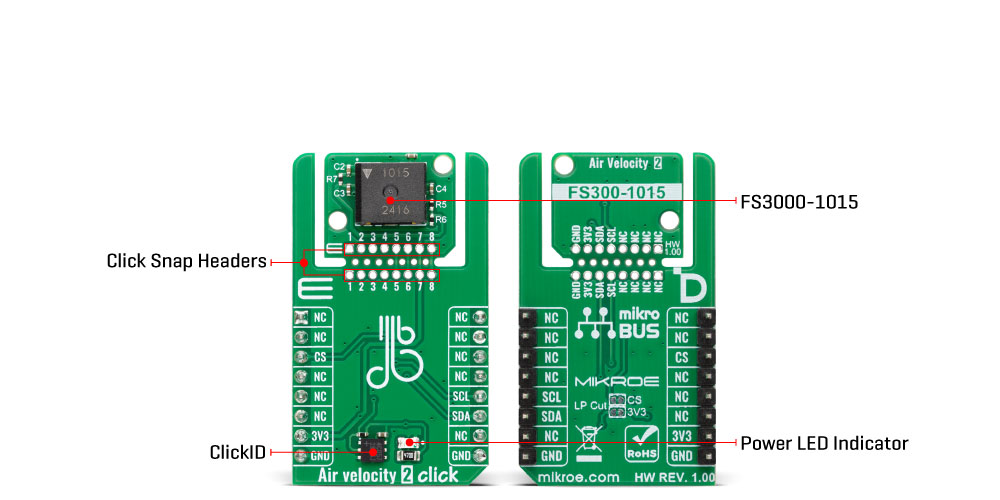OFF
GO LOCAL
| Company | Stock | Price |
|---|---|---|

MIKROE-6577
17 g
Status:
Air Velocity 2 Click is a compact add-on board that provides precise air velocity measurements for airflow monitoring in various environmental and industrial applications. It is based on the FS3000-1015, a digital air velocity sensor module from Renesas. This MEMS thermopile-based sensor offers 12-bit digital output resolution and supports air velocity readings from 0 to 15 meters per second. It features robust “solid” thermal isolation technology, a silicon-carbide protective coating, and high resistance to vibration, pressure shock, and surface contamination. The Click board™ uses an I2C interface and supports MIKROE's innovative Click Snap feature, allowing the sensor portion to be detached and mounted separately using the designated screw hole, enabling flexible installation and standalone operation. This Click board™ is ideal for applications such as HVAC systems, data center airflow management, laminar flow control, and air filtration or collection systems.
Air Velocity 2 Click is fully compatible with the mikroBUS™ socket and can be used on any host system supporting the mikroBUS™ standard. It comes with the mikroSDK open-source libraries, offering unparalleled flexibility for evaluation and customization. What sets this Click board™ apart is the groundbreaking ClickID feature, enabling your host system to automatically detect and identify this add-on board, alongside a Click Snap feature introducing a new level of flexibility and ease of use.
This product is no longer in stock
Availability date:
OFF
| Company | Stock | Price |
|---|---|---|

Air Velocity 2 Click is based on the FS3000-1015, a digital air velocity sensor module from Renesas that provides precise air velocity measurements. This MEMS-based sensor operates on the principle of a thermopile, offering a highly sensitive and reliable method for measuring airflow with a digital output resolution of 12 bits. Designed for demanding environments, the FS3000-1015 incorporates advanced “solid” thermal isolation technology and a protective silicon-carbide coating, making it resistant to surface contamination, abrasive wear, vibration, and pressure shock. It supports air velocity measurements ranging from 0 to 15 meters per second, corresponding to digital output counts between 409 and 3686.

The sensor's robust construction and compact surface-mount design make it suitable for integration into low-profile enclosures and applications that require long-term durability. Air Velocity 2 Click communicates with the host microcontroller via the standard I2C interface, operating at clock speeds up to 400kHz to ensure efficient and responsive data transmission. Its low-power operation and high accuracy make it ideal for use in applications such as data centers, HVAC systems, laminar flow controls, and air filtration or collection systems where reliable airflow monitoring is essential.
This Click board™ is designed in a unique format supporting the newly introduced MIKROE feature called "Click Snap." Unlike the standardized version of Click boards, this feature allows the main sensor/IC/module area to become movable by breaking the PCB, opening up many new possibilities for implementation. Thanks to the Snap feature, the FS3000-1015 can operate autonomously by accessing its signals directly on the pins marked 1-8. Additionally, the Snap part includes a specified and fixed screw hole position, enabling users to secure the Snap board in their desired location.
This Click board™ can be operated only with a 3.3V logic voltage level. The board must perform appropriate logic voltage level conversion before using MCUs with different logic levels. It also comes equipped with a library containing functions and example code that can be used as a reference for further development.
Click Snap is an innovative feature of our standardized Click add-on boards, designed to bring greater flexibility and optimize your prototypes. By simply snapping the PCB along predefined lines, you can easily detach the main sensor/IC/module area, reducing the overall size, weight, and power consumption - ideal for the final phase of prototyping. For more details about Click Snap, visit the official page dedicated to this feature.
Type
Environmental
Applications
Ideal for applications such as HVAC systems, data center airflow management, laminar flow control, and air filtration or collection systems
On-board modules
FS3000-1015 - digital air velocity sensor module from Renesas
Key Features
Air velocity measurement from 0 to 15 meters per second, 12-bit digital output resolution, MEMS thermopile-based sensing principle, robust “solid” thermal isolation technology, silicon-carbide protective coating, resistance to surface contamination, vibration, and pressure shock, compact surface-mount sensor design, I2C communication interface, low-power operation, Click Snap support, and more
Interface
I2C
Feature
Click Snap,ClickID
Compatibility
mikroBUS™
Click board size
M (42.9 x 25.4 mm)
Input Voltage
3.3V
This table shows how the pinout on Air Velocity 2 Click corresponds to the pinout on the mikroBUS™ socket (the latter shown in the two middle columns).
| Label | Name | Default | Description |
|---|---|---|---|
| LD1 | PWR | - | Power LED Indicator |
| Description | Min | Typ | Max | Unit |
|---|---|---|---|---|
| Supply Voltage | - | 3.3 | - | V |
| Air Velocity Range | 0 | - | 15 | m/s |
| Output Count Range | 409 | - | 3686 | - |
Air Velocity 2 Click demo application is developed using the NECTO Studio, ensuring compatibility with mikroSDK's open-source libraries and tools. Designed for plug-and-play implementation and testing, the demo is fully compatible with all development, starter, and mikromedia boards featuring a mikroBUS™ socket.
Example Description
This example demonstrates the use of Air Velocity 2 Click board by reading and displaying the output counts and air velocity in m/sec.
Key Functions
airvelocity2_cfg_setup This function initializes Click configuration structure to initial values.airvelocity2_init This function initializes all necessary pins and peripherals used for this Click board.airvelocity2_read_output This function reads the raw output counts by using I2C serial interface.airvelocity2_counts_to_mps This function converts raw output counts to velocity in m/sec (0-15).Application Init
Initializes the driver and logger.
Application Task
Reads the output counts and converts it to air velocity in m/sec. Both values will be displayed on the USB UART approximately every 125ms.
Application Output
This Click board can be interfaced and monitored in two ways:
Additional Notes and Information
The complete application code and a ready-to-use project are available through the NECTO Studio Package Manager for direct installation in the NECTO Studio. The application code can also be found on the MIKROE GitHub account.
NOTE: Please be advised that any peripheral devices or accessories shown connected to the Click board™ are not included in the package. Check their availability in our shop or in the YMAN section below.